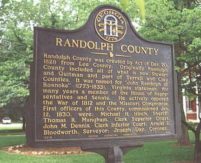 When the Board of Elections in majority-black Randolph County, Georgia introduced a proposal earlier this month to close seven of the county’s nine polling places, many residents were angry. Some even accused the Board of trying to hide the proposal.
When the Board of Elections in majority-black Randolph County, Georgia introduced a proposal earlier this month to close seven of the county’s nine polling places, many residents were angry. Some even accused the Board of trying to hide the proposal.
The truth is less damning: Even if the Board wanted to hide the plan, it would have been prevented from doing so by Georgia law, which required the county agency to publish two notices about it in a local newspaper. And the notices worked exactly as the law intended, drawing widespread attention to the proposal. In fact, it briefly received national attention, with many characterizing the plan as a Republican effort to suppress the African-American vote before this fall’s election. Nevertheless, when local activists accused the Board of a cover-up, some national media outlets took the bait. For instance, here’s how the Washington Post described the notice process:
“(Activists) say the board didn’t reach out to residents to discuss the plan. Instead a local activist saw it in the legal ads of the local newspaper and sounded the alarm.”
The Associated Press bit even harder. The national news service reported that Randolph County Democratic Party Chair Bobby Jenkins “came across the notice” as he was “(s)canning the local newspaper’s legal section with his magnifying glass.”
Astonishingly, both news organizations parroted Jenkins’ characterization of the public notice section of a newspaper as a place government officials go to publish matters they want to hide! They failed to recognize that newspaper notice is the legally sanctioned and most effective means by which state agencies formally notify citizens about their plans. They also failed to mention that by the time their stories were published the Board had already held two public hearings to solicit community feedback to the proposal.
Did the Randolph County Board of Elections really try to conceal the proposal? You be the judge.
On Aug. 9, the Board published two notices in The Southern Tribune, a 1,200-circulation weekly based in the county seat of Cuthbert. (Randolph County’s estimated population is 7,193.) A notice about the proposal appeared as a three-column advertisement at the bottom of page 4 of the Tribune. A smaller notice about the two hearings was published at the top of the same page.
[Read notices about the proposal published in The Southern Tribune]
The same notices were published in similar positions on page 4 of the Aug. 16 issue of the Tribune. In addition, the main story on the front page of that issue was about citizen opposition to the plan to shutter polling places. (Published next to the jump of that story on page 2 was a letter from local Democratic Party leader Jenkins opposing the proposal.)
[Read The Southern Tribune’s coverage of the proposal]
The proposal also dominated coverage in the Aug. 23 issue of the paper, which featured a banner headline and several stories about it along with a paid political announcement by Jenkins promoting a Black Voters Matter rally opposing “voter suppression efforts” in Randolph County.
The day after that issue hit the streets, the Board of Elections voted 2-0 to reject the proposal. The proposal had become so toxic by then that county officials fired the consultant who developed it and just about every public figure aside from the Pope had already condemned it.
So, to recount:
1. The Board of Elections issued a proposal and scheduled hearings
2. The agency followed the law and published several notices about it in a local newspaper
3. Local residents read the notices and sounded the alarms
4. The newspaper reported on the proposal and the opposition to it
5. The proposal was defeated
Leaving aside the outcome, that’s precisely how newspaper notice is supposed to work.
